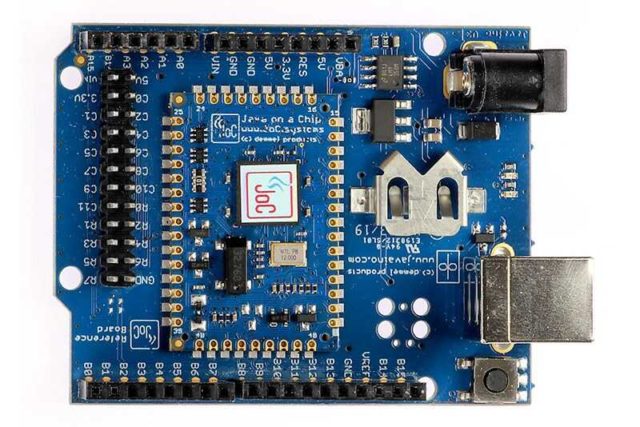There is a Java-programmable module on the block. The module is going to change the face of programming and make things easier.
The Java-on-Chip (JoC) module was designed by the Austrian manufacturer, Demmel. This module minimizes programming and development time of smart applications.
The first thing to remember is that commercially embedded systems are developed with programmable languages, and they typically employ the use of either the C language or assembly.
However, Demmel has made this new module and board specifically for Java programmers. The Java-programmable module is designed to work with the Javaino JoC reference board.
Another thing about the JoC module is that it radically shortens development times. Furthermore, it simplifies PCB design efforts and also reduces programming effort.
Also, the Java-programmable module comes as a tiny 24 × 36-mm module. As a matter of fact, it offers a diverse selection of interface options. Now, these options can be addressed in Java for low-level programming.

Specifications of the JoC Module
- Multiple digital and analog I/Os
- USB port, 2x RS232 (TTL) ports, I2C, SPI, and PWM outputs
- A/D and D/A converters.
- A built-in keyboard interface which can accommodate up to 128 keys
- There is also a rotary encoder interface.
Benefits of the Java-Programmable Module
- With the extensive interface options of the JoC, complex low-level programming is unnecessary.
- Compared to other languages, the approach and technology of Java offers security from errors.
- Additionally, the JoC real-time clock with battery backup is useful for time-sensitive applications.
Final Note
The Javaino JoC Reference Board brings all of JoCs pins out to edge pins. It is however important to know that you will need to buy the board. This will make the use of the Java-Programmable module quick and easy.
Both the Java-on-Chip module and the Javaino JoC reference board are available. They can be purchased directly from Saelig for $29.95 and $59.95, respectively.
Via EEWeb. Thanks to theguyuk for the tip.

Tiwalade Joanna Okedara is a content writer, and blogger, with a passion for all things tech. She also specialises in writing SEO content, and spends most of her time researching new content marketing strategies. She loves to cook, and plan events in her spare time
Support CNX Software! Donate via cryptocurrencies, become a Patron on Patreon, or purchase goods on Amazon or Aliexpress





I disagree with the use of Java in IoT project. Time consuming, heavy need of resource, poor performance, and now you should pay for using Java !
>I disagree with the use of Java in IoT project.
Why not? Java is a language. If you get the right outputs from your inputs and it all happens within the time envelope you have what does it matter?
>Time consuming,
More time consuming than chasing bugs in C code that randomly appear and disappear when the layout of the binary changes?
>heavy need of resource, poor performance, and now you should pay for using Java !
This is likely to be a very optimised JVM made for whatever common micro they’ve stuck a sticker on. Possibly something like https://en.wikipedia.org/wiki/NanoVM .. So there will be some overhead but if it fits and does what you need then I’m not sure I get your argument. Just stating memory use and performance with no actual criteria seems to be the common way trying to argue against something technically when your actual disagreement is entirely emotional.
But with such a VM you get all the problems you’re seeing with C because you’ll be affected by this VM’s bugs, and you won’t have the myriad of pre-made libs that make java devs happy not to have to reinvent the wheel. I fail to see what benefit it presents in this case, except maybe for those who were told by management “we’ll do java on this product, like it or not”.
You’ll be affected by not having memory protection either way. The benefit you get with Java will be bounds and null pointer checks before access. You might even get stack overflow checks.
Anyhow it’s weird to argue that something like this isn’t suitable for small systems when Java Card has been kicking around for about 20 years now.
This a moot point as the product isn’t remotely Java, but no need to spread FUD by concern trolling either.
openjdk is completely free as in both the speech and beer sense and is the common source-base for all current jdks. Oracle even provide binaries – but they’re not the only option and now it’s not difficult at all to compile the jdk from source (./configure && make && go get a coffee but don’t go too far as it wont take all that long). RedHat also put significant developer resources into it and provide officially Java-branded and certified binaries as well.
The LTS release are for enterprises who like to waste money on major version upgrades, for them the Oracle or RedHat support costs are lower than the version upgrade costs. For everyone else the latest release *is* the *fully* *supported* one you should use and and is no different from the regular patch releases that always existed. The “LTS” releases are poorly named because they don’t mean the same thing as “LTS” for other platforms like ubuntu, but this is merely a failure of marketing and not the technical merits of the approach.
This is a much much better situation than it was under Sun where the openjdk was always incomplete and buggy, difficult to build, and a separate codebase from the jdk and jre they published. And for many uses, the Sun JRE was certainly not free of cost either. Sun’s lasting legacy is finally freeing Java but before they did that it definitely was not free, in terms of speech or beer. I’ve got an irrational soft-spot for Sun as well, but they definitely don’t deserve the seemingly free pass everyone gives them compared to vitriol laced upon oracle (or microsoft for that matter).
LTS is not about wasting money on major version upgrades; they’re about stability. There’s no serious Java user out there who’s prepared to update their JDK every six-months. Believe me, I’ve spoken to a lot of customers about this (I work for Azul).
There’s also nothing poorly named about LTS. Long-term support means you can still get updates and support for an extended period of time. Depending on who is offering this it can be anything from five to nine years. What’s confusing about that?
Sun (who I also used to work for) created the OpenJDK project in 2007 and, yes, it took a while to get the full source code into the project but there was a *lot* of due diligence and effort required. JDK 7 b53 (in April 2009) was when everything was available as open-source. That was still Sun, not Oracle.
Oracle have maintained a different set of functionality for their JDK until JDK 11 when they eliminated functional differences between the OpenJDK source base and the Oracle JDK.
The Sun JDK was most definitely free to use for everything that was not embedded. Updates were free and overlapped for a good length of time with the previous version to allow an easy upgrade path.
end of battery-powered devices ?
>end of battery-powered devices ?
Linux is much heavier than whatever JVM they’ve integrated into this yet there are a lot of battery powered linux devices out there.
Will change face of programming, seriously?
What is this, reads like badly written adcopy? Seems to be on the rise on this site, too.
Not too much of a fan of these new authors.
This reminds me of Dallas Semiconductor’s TINI microcontroller board that could run Java, and the Javelin Stamp, and STM32’s STM32Java solution. None of these attempts to bring Java into the embedded world seemed to succeed. Who knows perhaps this fourth attempt will be the charm.
i recall reading a long while back where such a chip/capability of java acceleration was considered for android phones but then the whole lawsuit thing happened and it was scrapped
A lot of ARM cores had a Java execution state called Jazelle (https://en.wikipedia.org/wiki/Jazelle). That doesn’t really help for Android though as Android doesn’t run Java (as in the bytecode).
hoo boy does this look dodge!
Apart from the not terribly great article here, the site itself is riddled with typoes and poor English. Despite being ‘demmel products gmbh’ with Austrian contact details it reads more like a Mandarin translation than a German one, and other demmel products are shown with Chinese-language in screenshots so their products are obviously created there if nothing else.
There’s some weird stuff in the html, like “Cybersteel Inc. 376-293 City Road, Suite 600 San Francisco, CA 94102” – which shows up on the net in many places on very similar websites – is this like the ‘northwind’ of the Contao CMS they’re using? Just a template example that everyone copies or is it a shell company for all these sites? The tooltip “We are located in Europe” is very convincing however!
The MCU only runs at 100MHZ, 512KB flash and 32KB usable ram. Could be anything I guess. Reneses RX?
They provide no source, just a .exe for their ide. There aren’t any real screenshots in the docs, one would suspect it’s just eclipse but the shots they do show don’t look like it. I didn’t bother installing it of course.
The ‘java’ they ship isn’t even remotely close to Java 1.0. For example there is no java.lang.Class and most of java.lang.System is missing (so no JNI possible). Absolutely nothing they could legally call Java (or even ‘java’ as it often appears on their site). There is so little of the Java platform implemented there would be no need to run any sort of JVM so it’s probably just a native compiler. There would be no way to use any but the most trivial of ancient libraries on it and probably only then in source form since there’s no way it could load .jar files.
I thought maybe it was “microej” based but the microej javadoc looks to be a direct copy of the jdk and it has generics, whereas joc’s definitely is not and it doesn’t. As there’s no mention of Oracle(tm) or Java(tm) anywhere on either site, microej seems very suss as well. Similar looking shitty peacock of a website too, all feathers and no meat.
I suppose it’s a relevant device for this blog and it could have been an interesting product in the Arduino category, but it seems a more critical eye is in order least you damage your own brand which has taken years to establish.
We use Cinterion Java 2G and 3G modules. About 10Mbytes Flash, 2MB RAM, FileSystem, 2 Uarts, I2C, SPI, RTC, gpio… 2G for about half of this price…
Eclipse plugin and all of APIs.
Yes, I forgot I wrote about those Java modules a while ago: https://www.cnx-software.com/2014/12/22/gemalto-cinterion-concept-board-features-3g-connectivity-arduino-headers-for-secure-java-m2m-applications/